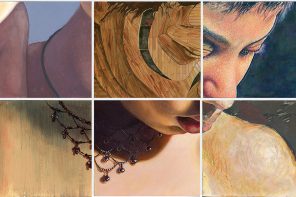This is the year of black — black wallpaper, black painted rooms, black kitchen cabinets.
Louise Nevelson would have been ecstatic. It’s dramatic, of course, but can a trend be artistic? Trends, by definition, follow in the wake of something created two steps ahead of them so we are co-opting someone else’s creative statement by chasing them. Some of the coolest interiors I’ve ever seen were imagined by fine artists and not interior designers, because artists govern themselves and so they are not bound by conventional aesthetic rules.
The important idea is the intention and a careful consideration of effective expression. I just read about a “sculpture” that was shown at MoMA PSI that is as literal as it is conceptual. It is a French horn (the instrument) stuffed with guacamole. Yes, you heard that right. Some brave/foolish art collector bought it and displayed it in his living room, carefully tending to the guac before it rotted. That’s commitment.
On the flip side, I went to someone’s house for dinner awhile back and noticed that the artworks on the walls were hung way above eye level, seemingly creeping toward the ceiling. These were not tall people. They told me they had used the previous owner’s already installed picture hooks to hang their own treasures (regardless of proportion and scale). It was visually odd and not in a fun way. I smiled and nodded. Really, most of us fall somewhere in between the extremes of hyper-curatorial and laissez-faire modes.
Before attending design school, I grew up with more of an art education than most, because my father, Dan Billet, is a landscape and architectural photographer. As a kid, I waited on the side of the road for the sun to appear at just the right intensity before he would consider snapping a single shot of the grass-covered dunes on the New England coast. I had to “wipe that look” off my face and sit stock-still while “looking natural” so that he could immortalize me in portraiture. The buildings he captured were stark and Edward Hopper-esque, giving the impression that the area was deserted. The finished frame never belied how much patience and calculation it took to stab at the subject in between groups of people walking by in either direction. Many of these images graced the walls of my parents’ home as well as those of extended family, friends and a few galleries. They were important not just because they were beautiful. Symbolically, they were portraits of my father, his soul as seen through a window with no curtains.
That view of him was not easy to come by as he toiled to support us, stoic and purposeful in all that he did. Here was his opportunity to take risks — creative risks substituted for the kind of literal risks that were not available for him to take in the real world — not if he was going to put us first, which he always did. He rendered scenes abundant in dignity and an order of the mind that depicted his character and deepest held beliefs. He risked public greatness, as a man who took no accolades, making space for a monumental vision of life made action by action in the everyday. His credo, “I wish for you what you wish for yourselves” is evident every time I look at his work, which radiates a poetry of stillness and simplicity of being, imposing in itself but never imposing on the viewer.
Don’t be afraid of displaying artwork in your home whether it’s yours or someone else’s. Take risks — express yourself, go all-in. And please hire a professional picture hanger.
For more, visit janemorganinteriordesign.com.




